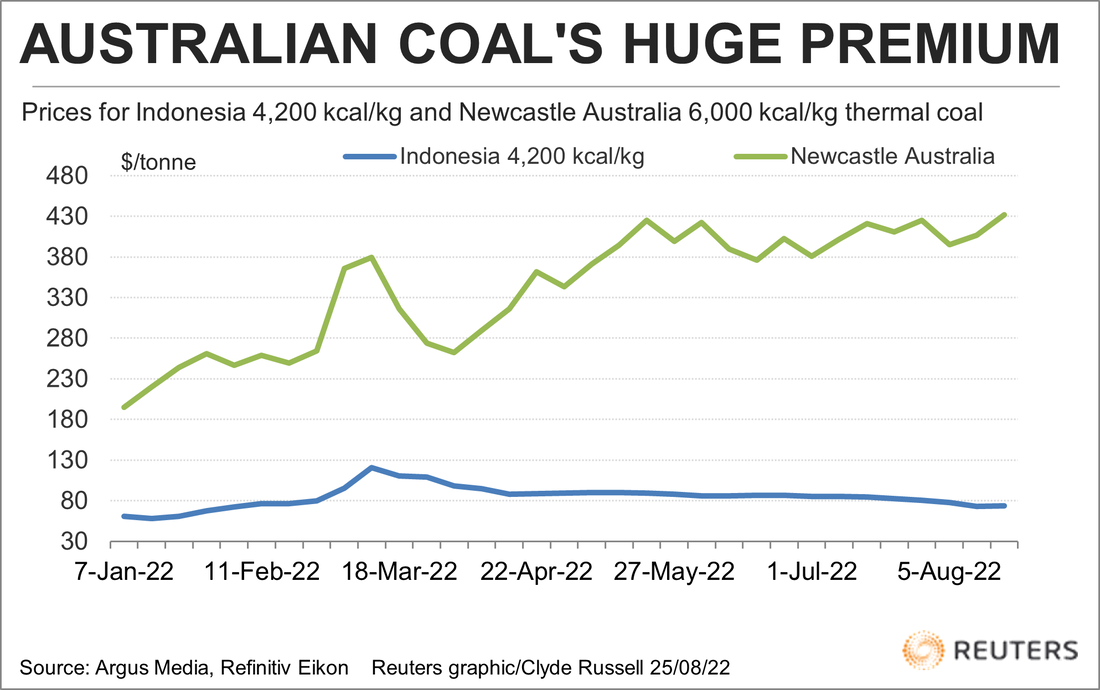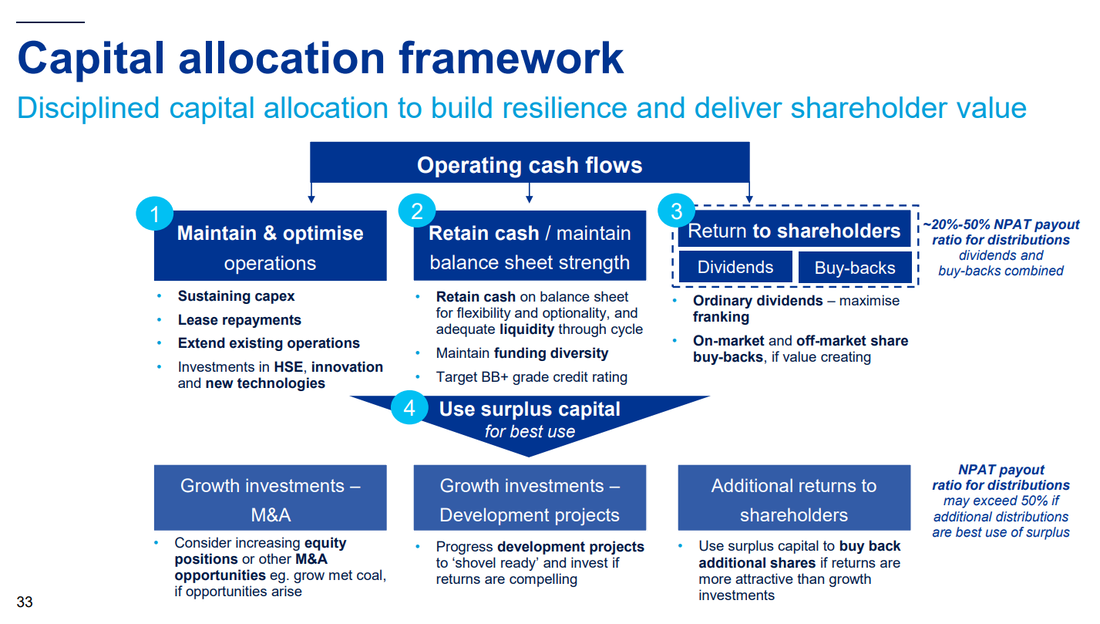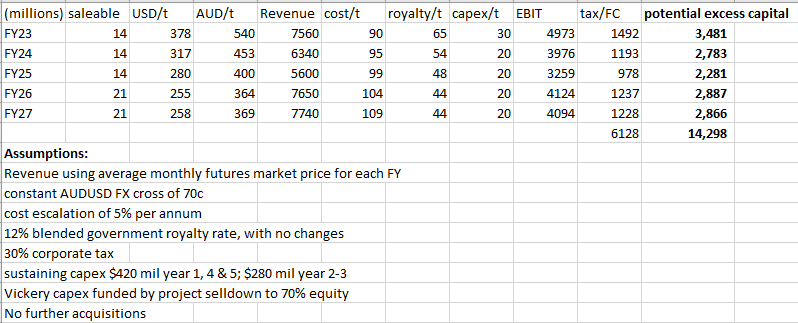Is Whitehaven still undervalued after its stellar result?
Whitehaven Coal reported a record profit result of $2 billion (NPAT) for financial year 2022. EBITDA (Earnings before interest, tax and D&A) rose an astounding 15 times the previous financial year, with a result of $3.1 billion achieved. Free cash flow generated from operations was exceptional at $2.6 billion.
This fantastic result was primarily driven by a range of factors including:
- A significantly improved realised coal price of AU$325/t up from AU$95/t from FY21;
- Consistent production within targeted guidelines of 20 million tonnes, despite workforce challenges and inclement weather;
- best-in-class cost control on a per tonne basis, significantly better than its peer group;
- and, an improvement in its workforce safety performance.
Unequivocally, this has been the standout result from amongst the ASX100, with a Total Shareholder Return (TSR) of 154% achieved for FY22.
Importantly, during FY22, the company took advantage of the favourable market conditions to significantly strengthen the balance sheet and reward its shareholders.
Specifically, Whitehaven was able to repay $775 million of debt, retiring all long-term liabilities; fully fund its capital expenditure out of its operating cashflow and finally return $1 billion worth of cash to shareholders via fully franked dividends and on-market share buybacks (a small part ongoing).
Whitehaven continues to experience exceptionally strong market and business conditions, with spot thermal coal prices (Newcastle specification) at circa AU$600/t versus AU$325/t pricing achieved for FY22.
Whitehaven continues to experience demand excess of its supply capabilities due to the high quality and highly-sought after nature of its coal products as well as its enduring relationships with East Asian customers primarily located in Japan & Korea.
Any supply response to fulfill demand is unlikely to eventuate for at least 2-3 years, even Whitehaven itself has been unable to lift production given constraints to permitting, labour and the sheer inability to finance new thermal coal developments.
Accordingly, existing high quality producers enjoy a significant and likely enduring competitive moat to any potential new entrants; and this is reflected in the spread between low and higher quality coal products.

We consider the forward outlook is exceptionally strong, with the ongoing global energy crisis and the peak demand season of the Northern Hemisphere winter mere months away; providing strong upside risk both at company and commodity price levels.
Whitehaven have emphasised its commitment to returning capital to shareholders via dividends and share buybacks, and we believe these initiatives will be strongly value accretive for shareholders.
We consider WHC's current market valuation, of a mere $7.3 billion, at a (backwards looking) price earnings multiple of only 3.5x to be materially undervalued given the strong outlook for the industry, the quality of the company's assets and the commitment towards aggressively returning excess capital to shareholders.
The form in which this excess capital is returned to shareholders is likely to be the key decision at this juncture. The company disclosed a capital allocation framework in their most recent presentation.

Most compelling to us is the method of returning capital to shareholders. Whitehaven have highlighted that excess capital may be returned via dividends as well as buybacks (both on and off market). This is structured in such a way that the 20-50% of NPAT will be returned as dividends and buybacks; with excess capital above this being deployed into further buyback if returns are more attractive than growth investments like shovel ready development projects & acquisition prospects.
What does this really mean for shareholders?
The first exercise we undertake is to attempt to forecast 5 years into the future; we chose this arbitrary number of years because we have transparent price discovery via the futures market. This is despite Whitehaven possessing a production weighted asset life of over 23 years for currently producing assets (ie. not inclusive of development assets).
Using monthly futures prices for the next 5 years ahead, we were able to derive the following high-level figures.

What this tells us is that within a scenario, using the listed assumptions, brings us to a cumulative, undiscounted excess capital sum of $14.3 billion, along with around $6.1 billion of franking credits at the end of the 5 year term. Do note this is purely on the projected financials and assumes zero terminal value for the remaining life of mine which would be ~18 years on a weighted basis.
The next question that could be asked is: What are the major risk factors with the hypothesis?
- A material fall in thermal coal prices. This would have to be underpinned by either a) a material increase in supply or b) a material reduction in demand. We consider a) to be unlikely over a 5 year timeframe due to the permitting process and development lifecycle in regions where high quality thermal coals can be found and mined. b) is also an unlikely event whilst alternative energy sources remain high as a result of almost a decade of under investment and given the present geo-political turmoil.
- Government royalty rates. As investors discovered recently in the case of assets located in Queensland, government royalty rates can change. Whitehaven's production assets are located in New South Wales; which is ostensibly considered a fairly business-friendly state. The incumbent state government have indicated within their budget that no royalty changes have been assumed. There is a risk that an incoming change in government may attempt to enact higher royalty rates than exist at present. This is a situation that is somewhat uncertain given the next NSW state election is early in CY23. However, even should a QLD-style royalty increase eventuate (effectively double of the royalty assumed); this would affect the value proposition only marginally over the 5 year period.
- Costs and inadequate capital allocation. Cost risk is a factor however, we take comfort from the fact that Whitehaven have controlled their production costs the best out of their ASX listed peer group, demonstrating strong operational management quality. We also take comfort from the clarity around capital allocation guidelines and structure articulated to investors, and trust the board will undertake initiatives that are most beneficial to shareholders' long-term interests. For instance, it makes no sense to invest in development projects and bear exposure to delivery and capital risk until the company as a whole trades at a much higher earnings multiple.
The final question is: what is the most effective manner to return capital back to shareholders in the most value-accretive fashion?
In my mind, this really comes down to an opinion of what the terminal business *could* be at the end of the 5 years period, as well as the operational performance over this said period.
At the present market value of ~$7.5 billion, Whitehaven is valued at around 1.5x projected EBIT for FY23 alone - an unheard of valuation for a high quality, multi-mine, listed and liquid business.Using our 5 year projection, effectively the present market value is approximately half of the projected post-tax cumulative excess capital sum; or only 36% if you include the franking (tax) credits accrued.
Accordingly, we believe the Whitehaven should undertake an enormous, aggressive buyback program as opposed to paying out dividends. If the market is unwilling to ascribe a fair value to the company's stock, then the company can recognise and attempt to capture the value differential itself for the benefit of its long-term shareholders.
Much of the allure around dividends in Australia stems from the potential distribution of franking (or tax) credits that can be passed through and utilised by the shareholder. With dividends, come other issues such as re-investment risk that are commonly considered by professional investors.
However, franking credits can be returned in other manners, such as via an off-market buyback. If franking credits have no been accrued, then an on-market buyback would be the preferred outcome. However, a buyback can be expressed using both methodologies assuming shareholder approval has been obtained.
There has been much confusion around the off-market buyback methodology, and we thought it would be useful to demonstrate how it may work in practice. The ATO allows a maximum discount to market of 14% for off-market buybacks, accordingly we have used this figure in our assumptions.
On-market stock sale scenario
Purchase price - $5
On market sale - $7.80
capital gain - $2.80
Net benefit to shareholder: Sale price only
Off-market buyback scenario
off-market buyback price - $6.71 (14% discount to market)
capital component - $0.50
dividend - $6.21
franking credits - $2.61
Total benefit to selling shareholder - $9.32 - ~19.5% premium to market price inclusive of tax credits, despite discount to market.
The off-market buyback methodology is well known on Australian markets, with plenty of precedents. For instance, BHP undertook a $7.3 billion off-market buyback in 2018. In addition, it allows investors to choose whether they wish to partake according to their own tax situation. For example, a foreign investor is unable to claim franking credits, so would be unlikely to partake; however, a retiree may enjoy tax advantages and may gain benefit from the franking credits distributed.
In summary, we believe that Whitehaven continues to look undervalued and the company should attempt to return capital aggressively back to shareholders via a combination of on and off-market buybacks as circumstances allow.
Access a unique portfolio of Australian growth opportunities
Datt Capital is a specialist in identifying high growth and special situation opportunities. If you share our passion for uncovering undiscovered gems, Datt Capital could be the right investment for you. Click 'CONTACT' below to get in touch with us.
2 topics
1 stock mentioned
1 contributor mentioned